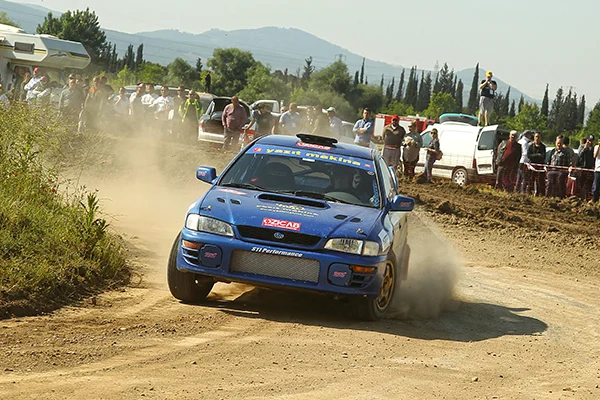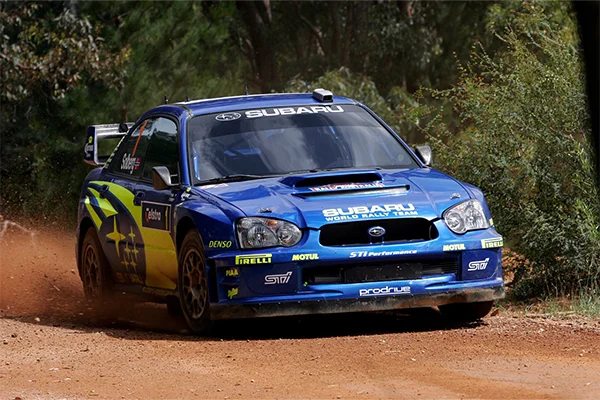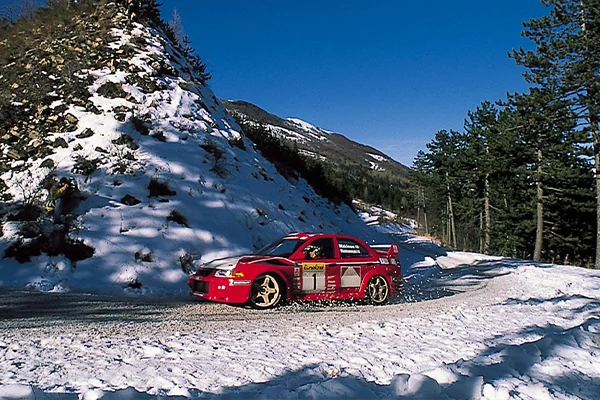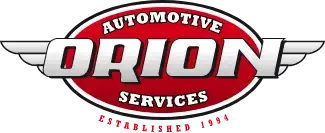What Does “STi” Mean On a Subaru?
When most hear the name Subaru, they picture rugged vehicles with a focus on practicality and safety; and in large part this is accurate. If you’ve ever watched a Subaru commercial, you know that this is the exact image the company tries to portray.
There’s a different side to Subaru though, one with almost a half-century of motorsport experience and known for a few of the world’s most renowned all-wheel drive performance vehicles; Subaru Technica International (STi).
You may not have seen many Subarus with the iconic red badging, but after reading this article, you’ll know exactly what makes this name so special and sought after when one finally passes you (trust us, it will be passing you).
The Birth of STi
Subaru Technica International was born and bred through the cutthroat rally racing scene of the 90s and early 2000s. Originally formed in 1988 to race in the World Rally Championship (WRC), a motorsport series based solely on flying through tight rural dirt backroads as quickly as possible. In turn, developing a chassis equipped for the tight tracks, mechanical abuse, and low-traction surfaces of rally racing was paramount to the program’s success.
Consumer performance divisions born through motorsports programs aren’t a unique concept, such as BMW’s M program in 1972 and Ford Special Vehicles Team (SVT) in 1991. However, while most of these brands built their consumer vehicles based on those competing in endurance, stock car, and touring car championships on perfectly paved road courses, STi was one of the only manufacturers putting out rally-inspired sedans with the 4WD and suspension setups to back that heritage up on a dirt track.
Subaru had been competing in WRC part-time for the eight years prior, albeit with little success. It wasn’t until 1989 that STi took the lead in developing their first rally car with the Legacy RS, marking a new beginning for Subaru’s motorsport image. It was also this year that Subaru began to officially compete under the name Subaru World Rally Team (Subaru WRT).
Cementing a Legacy
After a few more years of moderate success on the Legacy platform, Subaru signed one of the most celebrated rally drivers of all time: Collin McRae. This name may ring a bell for you, possibly through the series of successful rally video games that adorned his name and likeness on the cover, but also through the immense success in the WRC series he’s known for.
With McRae and Ari Vatenen starting the 1993 season, STi would go on to field their first Impreza-based rally car, which would remain the platform for their WRC entries. Finishing third in the 1993 Manufacturers’ Championship signaled future success for the Subaru World Rally Team and their Impreza 555.
1993 was significant for Subaru in more ways than one. By adopting the tobacco brand State Express 555 as their title sponsor, Subaru WRC cars would show up in a flashy new livery sporting their sponsor’s blue and yellow look. This color scheme would go on to define Subaru’s motorsports efforts, and the blue and yellow design became synonymous with success on a rally stage. Even after State Express 555 logos were pulled from the car, the team stuck with it. Subaru still offers the iconic blue shade as a paint option for their current vehicle lineup, appropriately named “World Rally Blue,” for those looking to add a little racing heritage to their new Subie.
These WRC efforts culminated in the 1995 season as Subaru would not only take home the Manufacturers’ title but also a Drivers’ Championship with McRae. Success would not slow down for Subaru WRT, this breakthrough was followed by two more Manufacturers’ trophies (1996 & 1997) and two more Drivers’ Championships trophies (2001 & 2003). The Impreza would go on to win 46 rallies, a record among individual models.
STi on the Streets
In most racing series, any competing manufacturer is required to “homologate” the vehicle. Homologation refers to the approval process to ensure competing vehicles fall within the regulations set by the governing committee of the series.
For racing series made up of vehicles that resemble their street-going versions (as opposed to open-wheel series like F1 or Indycar), a common step in homologation is to make sure that the race version of the vehicle isn’t too far off from what the brand offers in showrooms by requiring they sell a model with similar performance and technology to the race car in a street-legal form. This rule is in place to maintain the original principle of “production series” motorsports, taking modified street cars racing rather than manufacturers building purpose-built racing platforms that don’t resemble the consumer version of the vehicle besides a few body panels and a badge.
These regulations often lead to so-called “homologation specials”, or a limited consumer production run of that model that employs much of the performance hardware and technology of the race car (within street-legal regulations). Manufacturers usually only sell just as many of these models as they need to meet the FIA’s criteria for production runs (between 1997 and 2010 this number was 2500 units in the WRC). Homologation specials have become some of the most sought-after and renowned road-going vehicles, due to both their limited quantity and race-car-inspired performance.

The Subaru Impreza, being a relatively slow commuter vehicle with a focus on practicality and fuel economy in its regular form, differed extensively from its rally counterpart. The brand first introduced the Impreza WRX trim (short for World Rally eXperimental) to its native market of Japan in 1992 as a rally-inspired offering for their lineup and allowed them to homologate their Impreza 555 WRC car. Europe also got the first-gen WRX, but in a detuned version pushing out 210 HP rather than the JDM version’s 240; unfortunately, the North American market missed out entirely.
The WRX brought Subaru’s state-of-the-art symmetrical all-wheel-drive system and turbocharged boxer four-cylinder to the streets. They would also follow up with their “Type RA” trim of the WRX in Japan, an even more stripped-down version of the sedan, making an otherwise boring Impreza reminiscent of the rally cars that bear its nameplate.
The WRX STi
While the WRX and Type RA gave fans a taste of Subaru WRT performance and styling, Subaru wouldn’t bring a true STi-badged vehicle to public roads until 1994 when they released the first WRX STi (now known as the Version I STi).
If the WRX was just reminiscent of a rally car, the STi was as close as you could get in a consumer offering. It is built upon the WRX platform with a performance-tuned engine, transmission, and suspension setup. The STi was a relatively limited homologation special, starting at only 100 production units a month.
Subaru even offered a Type RA version of the already hardcore trim, removing “unnecessary” creature comforts like air conditioning and power windows to save weight. Again, the Japanese got this one to themselves. This no-frills trim was offered with grassroots motorsports customers in mind, despite also being street-legal.
STi and Subaru WRT continued their success on the rally stage with their first-generation Impreza rally cars and subsequently blessed us with five more WRX STi trims of the first-generation Impreza later on. These models are designated Version 1-Version 6 and are often denoted with Roman numerals (i.e. Version III instead of Version 3). These were sold throughout the Japanese and European markets, but not a single Version I-Version VI STi or WRX of this generation ever made it to the States.
In 2000, Subaru would phase out this generation of the base Impreza, and consequently both the consumer WRX and WRC cars built upon this chassis. Their replacement was a so-called “New Age” Impreza which brought a new age of WRX and STi versions with it.
The North American market finally got their wishes with the introduction of the 2002 Subaru WRX. While not an STi, America finally got its taste of a turbocharged AWD Subaru sports sedan.
They wouldn’t have to wait much longer for the real thing either, as Subaru brought their STi trims to the streets of the US in 2004. With four-wheel independent suspension, lowered ride height, three-point racing harnesses, improved steering ratio, and top-of-the-line (for the time) Brembo brakes all coming stock, the STi was a true econobox-turned-race car.

Subaru would continue the trend of new WRX releases and STi variants for each generation through the fifth, each with the styling and technology upgrades of the new Impreza and the rally-inspired DNA that we had come to expect from the WRX and STi editions. Over time the brand would drop the “Impreza” name for its performance counterparts, although this change happened at varying times and generations for different international markets. Subaru went beyond a name change in 2015 when the “first-generation” WRX was revealed as a standalone model with little relation to its Impreza brother and built on a different chassis.
Over the years these models would become highly regarded by car enthusiasts, street racers, and those looking to kick up a little dirt on an unpaved backroad. Buyers raved about the lightweight chassis combined with a punchy turbocharged motor and one of the most advanced AWD systems on the market. The WRX cemented itself as a cult classic for its value and unique driving experience, while the STi remained one of the rawest sedans and wagons on the market for a long time.
In 2021, Subaru revealed the “second-gen“ WRX, which was the first to use the Subaru Global Platform, a platform shared across the entirety of Subaru’s lineup (except the jointly-developed BRZ/86). Maybe even more surprising to enthusiasts was not the platform change, nor the discontinuation of the Impreza sedan it used to be built upon; but that the STi as we knew it may be dead.
No More STi?
Subaru hadn’t announced the axing of the STi brand, and they hadn’t explicitly stated there would be no future WRX STi either, but they did drop some major hints as to the future of the rally-bred performance brand.
In March 2022, Dominick Infante, Director of Communications at Subaru America stated the following which rattled fans of their boxer-four engine and accompanying iconic “Subie rumble” sound.
“A new WRX STi would have an incredibly limited shelf life,” Infante continued, “The [emissions] regulations are changing so quickly that it kind of wouldn’t make any sense.”
While nothing is official at the time of writing this article, it’s expected that the return of the STi name to a WRX would likely come when this gas-powered generation has run its course and in the form of an electric or hybrid drivetrain. We’ll have to see how that sits with purists if it does come to fruition.
Subaru vs. Mitsubishi: Rally’s Rivalry
We’d be doing the STi name a disservice if we failed to mention one of the most significant rivalries in both motorsport and consumer vehicles.
WRC was maybe the most competitive it had ever been during Subaru’s successful run. Subaru was not the only Japanese manufacturer that showed up with their take on an economy sedan platform taken to the extremes, nor were they the only one to have significant success with one in rally racing.
Ralliart, Mitsubishi’s performance division akin to Subaru Technica International, entered its first WRC season in 1989. In 1993, Ralliart would take the Mistubishi Mirage-based Lancer subcompact sedan and give it an STi-like treatment for that upcoming World Rally season. Thus, the Lancer Evolution name was born.

On the Evolution (Evo) platform, Mitsubishi would go on to take home four Drivers’ crowns and a Manufacturers’ Championship title between 1994 and 2007 (not to mention a couple of runner-up finishes in the Manufacturers’ title race in ‘95 and ‘96 to, you guessed it, Subaru WRT).
Continuing the similarities between the brands, Mistubishi would release their rally-inspired Evo in 1992, the same year the first WRX was offered. It was a Japan-exclusive model, however many also found their way into Europe through grey-market importing.
Mitsubishi would take a page out of Subaru’s book in 2003, offering the Evo to the North American market for the first time after seeing the success of the first American-sold STi a year prior. Matching a similar formula to what made the WRX and STi so successful, the Evolution would go on to see ten generations (labeled Evo I through Evo X in Roman numerals) up to the year 2015.
With the STi and Evo platforms so similar in performance and rally-DNA, the competition was cutthroat between them on the rally stage, in the showrooms, and on the street. Both the Evo and WRX/STi names would gain loud cult followings (usually loud towards each other) who passionately disagreed on the ultimate WRC-born four-door.
Things began to cool off between both automakers and their die-hard fans in the mid-2000s. In 2005, Mitsubishi would pull their full-time support and team from the World Rally Championship. Subaru would follow suit in 2008, citing the financial downturn as their reason for departure. Both brands still maintain a presence in rally in some form, although not nearly as involved or as often.
Not only were the motorsports divisions of these companies neutered, but that had a ripple effect on the road cars that were influenced by Ralliart and STi. As part of a complete restructuring of the company, Mitsubishi would pull the plug on the Evo name in 2015 with the final edition of the Evo X, followed by the entire Lancer line in 2018, with their sights set on electrification and practical offerings. Mitsubishi even revived its iconic Eclipse sports car’s nameplate as a two-row economy crossover in 2017 (…sigh). This company culture shift left Subaru as the sole producer of a tried-and-true formula for a sports sedan that so many desire.
That remains true today, as the WRX lives on in its sixth iteration with the same AWD, turbocharged four-banger, and “lightweight” chassis that made the original a success (lightweight relative to the behemoths that make up the automotive market today, not the original).
But even so, the lack of an STi, mixed reception to the new generation WRX, and the Mitsubishi-shaped hole left in the rally world has largely left the “golden era” of these cars one to be nostalgic of, even jealous of.
So, What Does STi Mean?
In short, STi is just Subaru’s performance division.
But in reality, STi carries so much of what makes Subaru memorable to enthusiasts and motorsport fans. The consumer products they got their hands on became the most desirable and beloved Subaru vehicles ever made (even their odd-yet-amazing Forester STi).
So next time you see a red badge on a Subaru, just know it’s probably something pretty special.
Subaru Service & Repair in Ann Arbor
Whether your Subaru is a WRX, STi, or otherwise, the experienced Subaru technicians at Orion Automotive Services in Ann Arbor, Michigan have the equipment and training to maintain your vehicle with the highest level of service. Give us a call or schedule online with our friendly team today!

